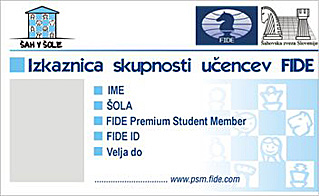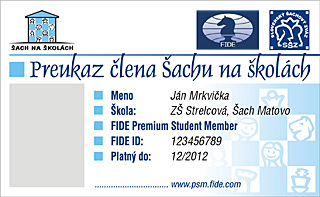| New FIDE web sites - Resources for federations, lots for kids |  |
| Friday, 27 January 2012 00:21 | ||
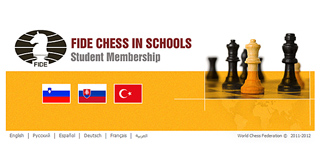 Federations, do you want more resources? Parents, do you want your children to play chess? Children, do you want a rating? Do you want to be on the same ladder as World Champion Anand? Student Member web site - NEW - in 9 languages At sm.fide.com register children for educational material and monthly newsletter - FREE 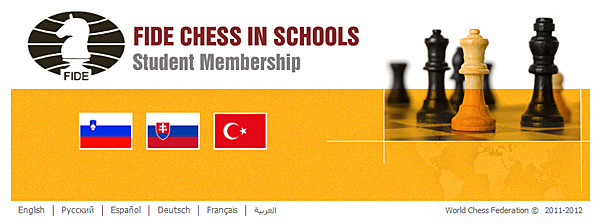 Premium Student Member web site - NEW - in 9 languages At psm.fide.com upgrade to Premium for just 10 euros - kids get RATING and much more 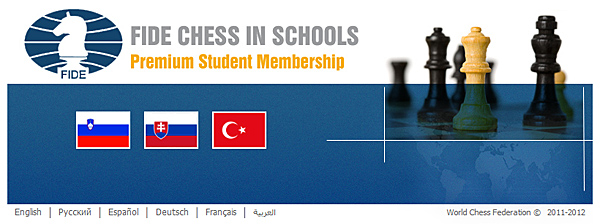 Please take a closer look (especially federation officials) at the CiS Manifesto and Roadmap to find answers to your questions: What is Student Membership? How will your federation benefit?  cis_manifesto__roadmap.pdf cis_manifesto__roadmap.pdfGens Una Sumus, We Are One Family our children are our future! CIS Manifesto - Big or small - Your children need you! Are you big or are you small? Whichever you are, there is something here for you. If you are one of the world’s largest federations, your budget may rival or even surpass that of FIDE. If you are small, your annual budget may be only USD 30,000, or even less. But are you as big as you want to be, as large as you ought to be? In our view, the answer is a clear "no." One of you has about 80,000 members, half of them juniors. However, that same federation has at least 500,000 (maybe a million) children playing chess in schools across the country. An 8% conversion rate is not bad in historical terms, but what if it were 20% or 30%? Wouldn't that make a big difference to your federation? Not just directly to your finances, but to your NUMBERS, and it is those numbers that carry weight, especially with potential sponsors. If you are small, growing your numbers will make an even bigger difference proportionately. FIDE has been accused of doing nothing to acquire sponsors. Such accusations are entirely unfounded, but it is true that we have not yet been entirely successful. FIDE has found many sponsors in the past quarter of a century, but most of them have been municipalities or from Russia. Let's think about Russia - why is it that so many events are supported by Russian sponsors? To us, the answer seems simple. Russia is one of very few countries that has already managed to build both an audience and a vault of potential sponsors because all the leading businessmen know about chess, they can play, they were brought up with it. It is that background that facilitates finding sponsors. The more children who encounter chess, the better. When they grow up, graduate and move into business and political life, so there will be an audience for chess and a business and political elite willing and able to support chess organizations to feed that audience. Let us help you to build your federation and your chess in schools programme. Our objective is to be able to generate more income for each and every federation than you pay to FIDE, much more. This reversal of flow of funds is something new for FIDE. For FIFA it is easy because of their huge income from the sale of TV rights. Regrettably, there is no such interest in the TV rights for chess events. To try and achieve these dual objectives (numbers and money for you), we have instituted FIDE Student Membership as part of our Chess in Schools programme. Originally, we had planned to phase this in with the CIS100 franchise modules, but we soon realised that the scope is much wider. Why should you promote FIDE Student Membership, rather than just push on trying to recruit more juniors directly to your federation? We believe that Student Membership offers additional advantages, especially the two Unique Selling Points. The USP of Premium Membership (€10 per annum, of which FIDE will take only €1) is a FIDE Student Rating. The USP of Basic Membership is that it is FREE (at no cost to you). We believe that this can reach youngsters that national federation membership may not attract, but you will benefit either way, especially if these children go on to take up BOTH memberships (Student and national federation), and we will be pushing them to do just that. Let us stress again, since there is so much cynicism and so many suspicious minds (especially in the media), that this is designed to help your federation and our multinational chess family build towards the objective of 1,000,000,000 chess players on the planet. Gens Una Sumus - Get in touch, let’s talk. But first, read on … What do you need to do to take advantage of this initiative? There are five options:
These options are not mutually exclusive, especially the fifth one which can and should be implemented if you are doing any of 1-4. What is Student Membership? What is involved in options 1-4? Read on! Please, send us your feedback to cis@fide.com. STUDENT MEMBERSHIP [SM = Student Member/ship; PSM = Premium Student Member/ship]
Basic Student Membership (SM) is free to anyone. The free version is handled automatically (more-or-less) by our web server (the only place that registration for free membership can be made). This is valuable, both to you and to us, because it adds to the number of your and our members, making chess ever more interesting to potential sponsors. However, the main interest is in Premium Student Membership (PSM with an annual fee of EUR 10). Why the flags? They are the partner federations (see below for more about partner federations). Premium Student Members (PSMs) get a Premium Pack for their €10 per year membership fee. The standard elements are: - plastic ID card - welcome letter - FIDE Student Rating - chess book - fortnightly newsletter containing practical tips, instructional material and puzzles - dedicated web site – a lollipop full of instruction and entertainment. These involve funding of USD 45,000 per annum, to provide the materials (and pay for some administration) for 100 chess classrooms in your country. Bidding for one of these projects involves a big commitment on the part of your federation. If you are prepared for that and want to bid, then send us some explanation of why you think you would make a big success of this. You should, as a general rule, have the backing of your Ministry of Education, if only as a general expression of support. If your bid is sufficiently convincing, we will send you a route map for that long road and then we can start discussing whether (and how) you can really implement it all. The funding is in the form of a loan, to be repaid out of PSM fee income. You decide what benefit(s) to provide your Student Members with. That is in addition to the standard elements. This is based upon the CIS100 module, but it should be possible rapidly to saturate the schools in your country. The coordination will be a great deal less onerous (although you may need to provide a lot of translation if your main language is a minority one). Funding will be in the region of USD 15,000 per annum. The funding is in the form of a loan, to be repaid out of PSM fee income. 3. Seeding We are aware of quite a few countries with fair size populations but small membership of federations which lack the resources even to bid for a CIS100 Project. Our idea to help them is to provide them seed funding of about USD 5,000 per annum. The idea is for that seed funding to be used to promote SM & PSM within your territory. By building up the number of SMs and especially PSMs, to grow your income (and ‘presence’) to the point that you can at least manage option 5 and perhaps graduate to a CIS100 project. 4. Harmonious collaboration The experience gathered by us at CIS (from many dozens of national federations) means that FIDE can offer you something greater than the sum of the parts. We want to work with you to grow numbers. We offer you the benefit of our (and your!) experience. 5. Simple Partnership This is very similar to option 4, but presumes a much greater involvement by us and much less by you (so more suitable for less developed federations). Options 1-3 will generally run for an initial term of three years. Contracts to be agreed. PARTNER FEDERATIONS Our initial partner federations are the CIS100 pilot project countries. However, we would like every single national federation to partner this initiative under option 5 above. What are the benefits?
What are the obligations?
TIMELINE We will be finalizing this year’s projects soon after the next Presidential Board meeting, which is just a few weeks away (3-6 February), so try to make your pitch before then. Get in touch, let’s talk. Your feedback (to cis@fide.com) can help us to improve this never-ending project. Ali Nihat Yazici Chairman, FIDE Chess in Schools
|
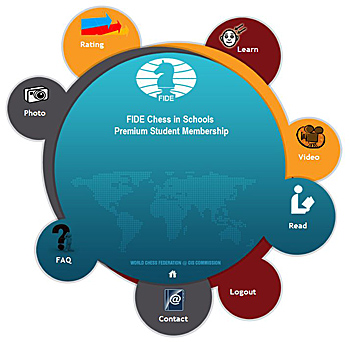 We introduced Student Membership to form a part of the CIS100 projects. It can also be a stand alone module. The big difference is that ANY federation should be able to manage this and enjoy the benefits.
We introduced Student Membership to form a part of the CIS100 projects. It can also be a stand alone module. The big difference is that ANY federation should be able to manage this and enjoy the benefits.